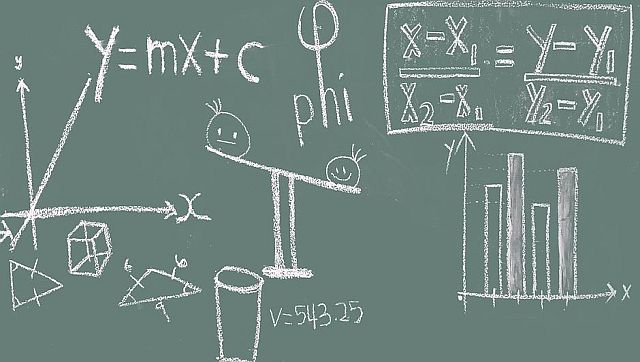
[ad_1]

UK prime minister Rishi Sunak just lately proposed making the research of arithmetic compulsory for all college students in England up to the age of 18. AFP
UK prime minister Rishi Sunak has proposed making the research of arithmetic compulsory for all college students in England up to the age of 18, to assist younger folks “in a world where data is everywhere and statistics underpin every job”.
Extending compulsory maths education previous 16 isn’t a brand new thought. It has been recommended by different ministers and has failed to materialise. What is evident, although, is that the prime minister’s reasoning is grounded actually. There is a mathematical abilities scarcity within the UK.
The authorities’s 2017 Smith Review discovered that solely round 20 per cent of scholars on non-STEM levels in larger education have studied arithmetic after the age of 16.
A Nuffield Foundation report, which in contrast England, Scotland, Northern Ireland and Wales to 20 different developed nations (together with Estonia, Spain, Japan, Korea and Russia) discovered that they have been 4 of solely six nations that didn’t require any arithmetic research after 16.
What’s extra, round half of adults within the UK are reported to have the identical stage of numeracy as is anticipated of a kid at major faculty. This lack of maths abilities has been estimated to price the UK £20 billion per 12 months.
Limited assets
However, Sunak’s plan has been met with criticism. A hurdle to the thought to lengthen maths educating is the widespread scarcity of maths lecturers. This scarcity is compounded by lecturers leaving the career. Approximately a 3rd of all lecturers have left 5 years after qualifying.
There are additionally problems with funding. Schools have had to make price range cuts, which means that they’re struggling to provide the mandatory provisions to their employees and college students.
While the federal government has not as but specified what type post-16 compulsory maths would take, Sunak made it clear that he was not intending that every one pupils ought to take A-level maths. Instead, the federal government is exploring choices which embody present {qualifications}, reminiscent of core maths.
The topic was introduced in 2013 and has been taught since 2015. It differs from A-level maths by specializing in matters reminiscent of finance, modelling, optimisation, statistics, likelihood and threat in a approach which favours the applying of those concepts slightly than the speculation behind them. Most of the background mathematical abilities wanted are at an identical issue to GCSE maths.
Expanding core maths
If the federal government is dedicated to extending post-16 maths, making core maths compulsory (for many who don’t take A-level maths) may effectively be the best choice.

Extending compulsory maths education previous 16 isn’t a brand new thought. It has been recommended by different ministers and has failed to materialise. Image used for representational functions/Pixabay
The added benefit of core maths is that it doesn’t strictly require lecturers to be topic specialists, although lecturers will need to have a reliable stage of arithmetic data.
It is meant for A-level college students who’ve handed their GCSE maths however who aren’t taking A-levels in maths. It could be taught alongside present A-level {qualifications}, carrying the identical variety of UCAS factors as an AS-level (roughly equal to half an A-level). It could be taught in a single 12 months or unfold over two.
The variety of college students taking core maths has grown, if slowly: from slightly below 3,000 in 2015 to simply over 12,000 college students in 2022.
A restricted variety of additional education schools have made the qualification accessible.
Universities have additionally been sluggish to recognise the qualification, as core maths doesn’t depend as one of many three required A-level {qualifications} which universities historically base presents on. However, some universities have began recognising core maths of their presents to college students.
Some post-16 instructional pathways which aren’t based mostly on A-levels have already got some type of compulsory arithmetic. These embody the International Baccalaureate and a few vocational {qualifications} reminiscent of T-Levels.
In addition, college students in post-16 education who’ve failed to attain a stage four or grade C in GCSE arithmetic should resit this qualification till they obtain a go.
However, if Sunak’s statements are right in that there’s such an apparent want for arithmetic to be made compulsory till the age of 18, this may counsel that GCSE arithmetic isn’t adequately assembly the wants of scholars.
The causes for the low uptake of arithmetic after the age of 16 usually stem from points which learners face at a a lot youthful age.
Many younger folks really feel excessive nervousness about maths and even a robust dislike in the direction of the topic. It may be that the prevailing arithmetic curriculum ought to be rigorously thought of earlier than post-16 arithmetic is made compulsory.![]()
This article is republished from The Conversation beneath a Creative Commons license. Read the authentic article.
Read all of the Latest News, Trending News, Cricket News, Bollywood News,
India News and Entertainment News right here. Follow us on Facebook, Twitter and Instagram.
[ad_2]
Source hyperlink